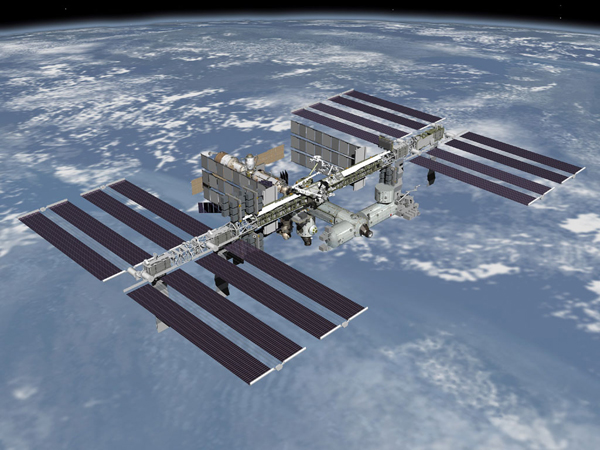The International Space Station (ISS) - the manned space station, used as a multipurpose space research facility. ISS - a joint international project, involving sixteen countries: Belgium, Brazil, Britain, Germany, Denmark, Spain, Italy, Canada, Netherlands, Norway, Russia, USA, France, Switzerland, Sweden, Japan.
The construction of the ISS began on 20 November, 1998 with the launch of the Functional Cargo Block Zarya. Now, the station consists of the following units:
- Zarya - Functional Cargo Block, the first module of ISS delivered to the orbit. Module weight - 20 tons, length - 12.6 m, diameter - 4 m, capacity - 80 m ³. It is equipped with jet propulsion engine for orbit-trimming of the station, and large solar cell batteries. It was launched on November 20, 1998.
- Zvezda - Service Module. Zvezda is provided with flight control system, crew life support means, power and information center, as well as cabins for cosmonauts. Module weight - 24 tons. The module is divided into five compartments and has four docking units. All of its systems and components are Russian, except for onboard computer system, created with the participation of European and American specialists. The module was launched in 2000.
- MRM - Mini Research Modules - two Russian cargo modules Rassvet (MRM-1) and Poisk (MRM-2) designed for storing equipment required for scientific experiments. The Poisk is docked to the zenith docking port of the Zvezda module, and the Rassvet is docked to the nadir port of the Zarya module.
- Pressurized adapter (Germoadapter) – a pressurized docking adapter designed for connecting modules of the ISS and for shuttle dockings.
- Tranquility - the ISS module, which life support system recycles waste water for crew use and generates oxygen for the crew to breathe. In addition, Tranquility contains an atmosphere revitalization system to remove contaminants from the atmosphere and monitor/control the atmosphere constituents of the ISS. The Tranquility is docked to the Unity module.
- Unity - Unity interface module was the first module of ISS American Segment, operating as a docking port and a switching network for the modules Quest, Node-3, Zenith segment Z1 truss and transport vehicles mating it through Germoadapter-3.
- Pirs - docking compartment, which is a part of Russian segment, docked to the Zvezda module and is meant for Soyuz and Progress vehicles docking.
- ESP - external stowage platforms, three external unpressurized platforms designed exclusively for storage of cargoes and equipment.
- Trusses – a unified structure, on the elements of which solar cell batteries, remote manipulator system and radiator panels are installed. It also intended for unpressurized storage of cargoes and equipment;
- Kanadarm-2 or Canada's remote manipulator system, which serves as the key tool for unloading of transport vehicles and moving external equipment.
- Dextre - Canadian system, consisting of two remote manipulators and serving for moving equipment, located outside the station.
- Quest - Airlock, which is intended for EVA activities with use of Extravehicular Mobility Unit and “Orlan” spacesuits. It is a pressurized module consisting of two compartments (they are connected by means of bulkhead and hatch): crew compartment, which is used for EVA, and instrument compartment where all the suits and instruments are stored. There is also the equipment for nitrogen removal from blood. Such procedure allows to avoid decompression when astronaut returns from vacuum into pressurized volume.
- Harmony - a connecting module, operating as docking unit and a power switching network for three scientific labs and transport vehicles that dock to it through Germoadapter-2. It contains additional support systems.
- Columbus - the Europian laboratory module which contains science equipment as well as switching networks (hubs), which provide connection of computer facilities.
- Destiny - the primary operating facility for US research payloads aboard the ISS. This equipment is used for experiments on microgravity, medicine, fundamental biology and ecology, for Earth observation and other applied tasks. Destiny is docked to forward port of Unity module.
- Kibo - the Japanese Experiment Module (JEM), consisting of three compartments and one basic remote manipulator. It is the largest single ISS module. The module is intended for implementation of physical, biological, biotechnological and other scientific experiments in pressurized and unpressurized conditions. In addition, due to special design, the module allows to carry out unplanned experiments. Kibo is docked to the Harmony module.
- Cupola - an observatory module. Its seven windows are used to conduct experiments, dockings and observations of Earth. The Cupola provides an observation and work area for the ISS crew giving visibility to support the control of the space station remote manipulator system and general external viewing of the Earth. The Cupola is mated with Tranquility module (Node 3).
ELC - an ExPRESS logistics carrier is an unpressurized attached payload platform for the ISS. It comprises four unpressurized platforms fixed at trusses 3 and 4. An ELC provides scientists with a platform and infrastructure for implementation of scientific experiments in vacuum. The platforms provide data processing and transmission of the results of experiments on high-speed channels towards the station.

The first long-term expedition to the ISS began on 31 October, 2000. The crew comprised William Shepherd, Yuri Gidzenko and Sergey Krikalev. During the 142 days space flight Expedition 1 crew performed wide scope of operations on activation and equipping of the ISS systems, service maintenance operations, and deployment of primary and auxiliary equipment. Service operations for two Progress cargo transfer vehicle were performed. Joint operation program with three visiting crews onboard space shuttle was performed. As a result, station was equipped with P6 truss, Destiny module, more than twenty tons of cargo and equipment were delivered onboard the station for crew life support and further station development. Wide scientific research and experiment program was successfully performed.
International nature of the ISS project promotes collaborative scientific experiments.


